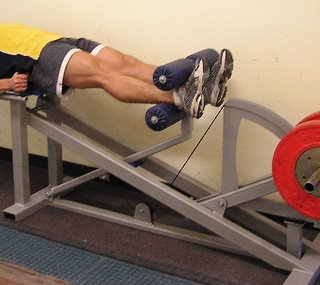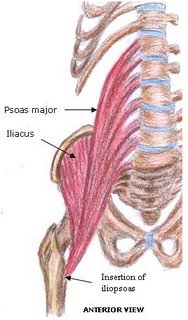Baggett argues that the glutes are mainly responsible for the 'horsepower' factor and does not believe that an athlete can have too much glute strength. He maintains that "due to their natural strength and the leverage advantage they have over your legs, the glutes should always be the primary muscles that drive lower body movement.
Inhibited glutes and overshadowed glutes
In extreme cases the glutes may be inhibited to the extent that they don't contract when walking, standing or even playing sport, but the more common problem for the athlete is having "overshadowed glutes":
Here the glutes DO fire correctly, but are not as strong as other lower body muscles (like the quadriceps), thus the body will use other muscles to do what the glutes SHOULD be doing, resulting in inefficient
performance and often some type of pain or injury over the long haul. Whenever you perform a movement such as a squat, lunge, deadlift, jump, sprint, or any exercise that involves several different muscle groups, the majority of work will tend to be done by the strongest of those muscle groups.
People who don't have superior glute activation patterns and whose glutes are not naturally stronger than their thighs perform exercises in the weightroom that should be strengthening their glutes but typically end up with most of the strengthening occurring in the thigh muscles. Then "when you throw them into an athletic environment the body will naturally use the strongest muscles to control movements, so now their quads and other muscles will want to do what the glutes should be doing." People who tend to easily develop massive quadriceps are usually not very impressive athletically:
A person with overly developed quadriceps and lack of hamstring and glute development will tend to be a heel to toe runner and have trouble gliding, planting, and getting off on the balls of their feet. ... Even if the posterior chain is developed, in someone that has massive quadricep development, they will still struggle with ideal movement patterns because their body will try to do things that favor the stronger muscle groups.
Extensor dominant movement for speed
In another article, "Squats and speed development?" Baggett suggests that blazing speed derives from "extensor dominant movement." He advises:
for speed development you get away from focusing on exercises where you "bend your knees" and focus on exercises where you extend your hips. So, get away from squatting and focus on extending, where the focus is high RPM strength, which I truly believe a person can never have enough of. That means everything on the backside of your body becomes more important.
Hip-joint-specific strength apparatus

MyoQuip's latest release, the MyoHip, provides a biomechanically efficient means of exercising and strengthening the hip extensors - glutes and hamstrings - without activating the knee extensors. In addition it is very effective in strengthening and enhancing the functionality of the hip flexors, which are the antagonists of the hip extensors.
Read more...














